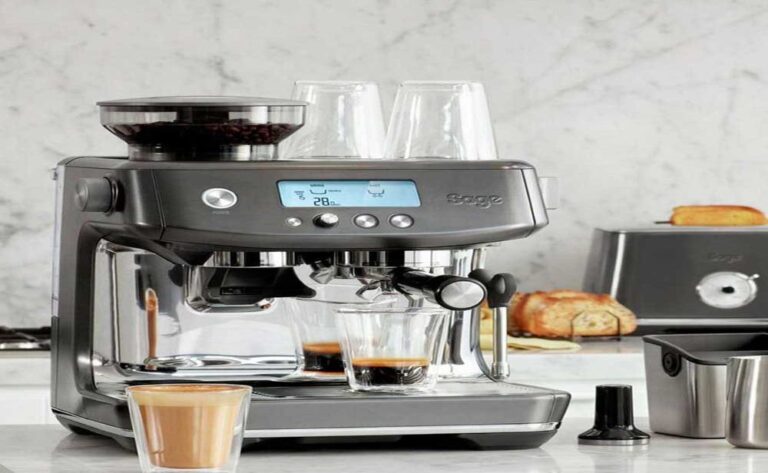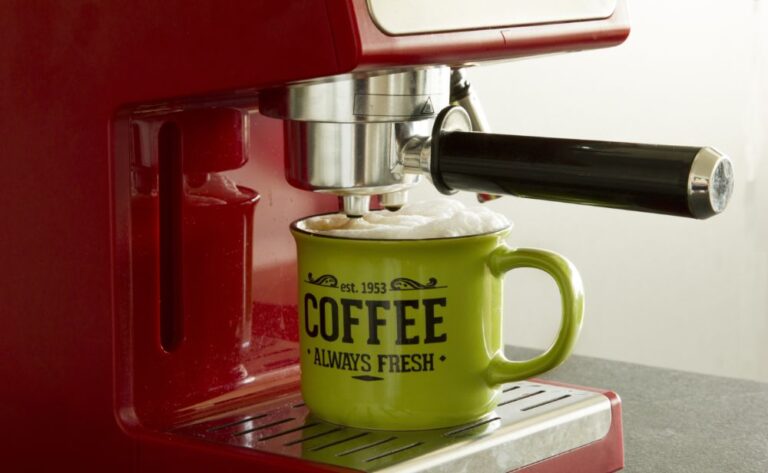
You are surely aware that regular maintenance is the most important factor in determining how long a machine will last.
But could you please explain that in more detail?
There is no need to panic if you do not know how to clean the Breville espresso machine.
I got you.
I’m going to offer all you need to know in this article about how to properly maintain a Breville coffee machine.
Let’s not waste any time and get started.
Instructions on How to Clean a Breville Espresso Machine
Do you want to ensure that your Breville espresso maker will continue to perform admirably for many years to come?
Then it is imperative to do the necessary maintenance. This involves “deep” cleaning and descaling on occasion, in addition to the standard everyday cleaning.
A Quick and Easy Guide to Cleaning
Do you make coffee from scratch each morning?
Then, before you call it a day, there are a few maintenance chores that need to be completed in order to keep your device in pristine condition.
Don’t be concerned; accomplishing it won’t require a significant amount of your time at all. However, it is possible that it will lengthen the life of your Breville espresso machine.
Clear the Drip Tray of Any Liquid.
It does not take very long for the drip tray to become completely soaked with water. If you let that water lie there for a few days, you not only run the risk of it overflowing, but you also increase the likelihood of it becoming contaminated with bacteria. Yuck.
When using a Breville coffee machine, which displays a “empty me” message whenever the drip tray is full, it is difficult to forget to perform what needs to be done.
Take the drip tray out of the cabinet and empty it into the sink. After that, give it a thorough washing. It also won’t harm to use a little dishwashing liquid if you want to be thorough.
After you have finished, you should wait until the drip tray has completely dried out before replacing it. In this approach, the machine won’t be able to confuse the tray’s presence of moisture with the presence of water.
Clean off the Surface of the Machine.
Because it is handled multiple times while operation, your espresso machine will inevitably amass dust and filth. When you use the machine, you not only risk spreading germs to other people but also yourself. All of it can, thankfully, be easily avoided.
You don’t have to polish your espresso machine every day, but giving it a quick wipe down with a damp cloth once in a while can help get rid of any dirt that has accumulated.
Scrub the Steam Wand well.
After each time you steam milk, you should immediately clean the wand that you used for the process.
Milk, as you probably are aware, goes bad quite rapidly if it is allowed to sit out at room temperature. If you don’t clean the steam wand in a timely manner, this is exactly what will happen in the event that there is any milk residue inside of it.
Now, I’m sure that bacteria is the last thing you want to have inside of your equipment.
To prevent this from happening, you will need to clean the wand as soon as you have finished foaming the milk.
Adjust the settings on the wand so that it produces steam and wait until there is no more liquid flowing out of it. Wait until the wand has cooled completely before cleaning it with a moist cloth.
In the event that you discover that the pressure coming from your steam wand is significantly lower than it was in the past, the tip may be obstructed.
Do you remember the brush that was included with the Breville coffee machine you purchased?
In situations like this, having it is quite helpful.
However, there is another option available to you in the event that the issue continues to exist despite the application of the tool.
Remove the screw from the end of the wand, then submerge it in a solution consisting of hot water and cleaning powder. This ought to solve the problem.
Purify the Portafilter, as well as the Basket.
In addition to this, as soon as the coffee has been brewed, you need to move on to the next step.
To begin, let’s get rid of any used grounds that we have. Tap the portafilter over the wastebasket so that any grinds that are left over flow directly in.
After that, use some warm water and soap to clean the portafilter as well as the filter basket.
Avoid using a dishwasher if at all possible. Running the parts through a cycle increases the risk that they will become damaged.
Deep Cleaning Guide
Now comes the portion that is a little bit more laborious.
The frequency with which you should complete the thorough cleaning should, in all honesty, be determined by how frequently you use your equipment.
However, you should try to give your machine a thorough cleaning at least once every month if you want it to remain in good working order. Naturally, doing it on a more regular basis won’t do any harm.
Cleaning of the Brew Head
Even if you clean the portafilter and basket on a daily basis, there is always a potential that coffee grounds will become lodged inside the brew head. This is because coffee grounds are sticky.
To begin, what you need to do is run a cycle that consists of only water. Because you are going to give it a lovely look, put a cup underneath it to catch the water that comes through.
In an ideal world, it should be completely transparent. If, on the other hand, it has a yellowish or brownish hue, this indicates that there is oil buildup and coffee residue on the inside.
In that case, go ahead and take the cleaning item that you had been utilizing in the past for the purpose of cleaning the steam wand. Utilize it so that you can clean the openings in the filter. I am aware that it does not appear to be a work that would be enjoyable to complete. However, doing so is essential in order to keep your system in good operating order.
Alter the Settings on the Water Filter.
Now, I’ve seen folks online genuinely suggesting that you rinse the filter and then replace it in its original location. I found this information on the internet.
Believe me when I say that this won’t function as well as they hoped it would.
The lifespan of a water filter is comparable to that of any other product. The precise period of time is going to be determined by how frequently you use the machine. But as a rule of thumb, one to two months is a decent estimate to use.
Scrub the Milling Machine.
Do you own a model that comes equipped with a grinder?
Additionally, this component requires regular maintenance.
To our good fortune, tackling that problem won’t be too difficult.
It is recommended that you use a brush to remove the coffee grounds from the filter at regular intervals.
No water. Both water and soap have the potential to deteriorate the grinder over time and make it more susceptible to rust.
Descaling Guide
Last but not least, we must not overlook the importance of descaling.
Why should you descale your Breville espresso machine?
Calcium and magnesium are two of the many types of minerals that may be found in water. As you undoubtedly already know, water also contains other types of minerals.
In addition, these minerals can accumulate inside of your espresso machine, leading to the formation of limescale (this is most likely to occur if you use hard water).
It is correct to say that the water filter was installed in order to address this issue. However, the mineral concentration of the tap water in some locations might be extremely considerable. Therefore, it is only logical that some of them will succeed in getting through.
However, that is not a problem that we cannot solve.
Descaling an espresso machine made by Breville is not a particularly difficult task. You will just need two items to get started:
• Cleaning disk
• Tablets for cleaning the house
To be fair, it is a well-known fact that you may create your own cleaning solution using white vinegar instead. However, cleaning disks and tablets are included in the package, so there is no valid excuse for you not to attempt using them.
You will afterwards be able to choose which option served you best.
Now, let’s descale your espresso maker. The procedure is straightforward, and it won’t take more than a few minutes of your time to complete it. The following is what you are need to do:
1. Insert the cleaning disk into the holder for a single cup.
2. After that, place the cleaning tablet inside the container.
3. Put the portafilter back where it belongs, as if you were going to make coffee with it.
4. While holding down the power button, press and release the 1-Cup and 2-Cup buttons simultaneously. As soon as you see the cleaning light begin to blink, you can let go of the buttons. The cycle of cleansing ought to get started.
After the descaling process is finished, you should put the machine through a couple of brewing cycles without adding any coffee. This is to ensure that there is not any residue left over from the cleaning tablets. There is no risk involved, although the coffee can end up tasting a little strange and soapy as a result.
Simple Suggestions Regarding Routine Maintenance
When it comes to espresso machines, there is no such thing as having too much order and cleanliness.
In point of fact, there is nothing wrong with taking your Breville to Monica Geller levels of excess.
Therefore, in order to ensure that your espresso machine is always spotless, here are a few pointers that you can integrate into your regular maintenance routine.
Always use a clean cloth that has recently been laundered – When cleaning different components of your machine, always use a cloth that has recently been laundered at a high temperature and is clean.
It is not recommended to use detergent on components that come into direct touch with coffee since regular soap might leave behind a residue that is corrosive to oils. It is not desirable for the oils that are present in your coffee to be degraded as it is being brewed.
Do a fast flush after each shot. This is something that should be be done once a week for maintenance, but it won’t harm to do it after each brew instead. Simply said, doing so will make the work of deep cleaning a lot less difficult.
You should get rid of used coffee as quickly as you can, and you shouldn’t leave used coffee grounds in your portafilter for an excessive amount of time. After they have hardened, this will just make it more difficult to clean.
Replace the water in the water tank on a consistent basis It doesn’t matter how frequently you brew coffee; you should always make it a point to change the water that’s stored in the water tank on a regular basis. In a perfect world, at most once every four days.
Closing Remarks
As can be seen, the upkeep of a Breville espresso machine does not need an excessive amount of effort.
The steam wand and the portafilter are two examples of components that need to be cleaned on a daily basis.
Regarding the other questions, the answer is dependent on how frequently you use your device. But as a general rule, it’s recommended that you do it once every month.
Last but not least, you should descale your system every one to two months at the very most.





